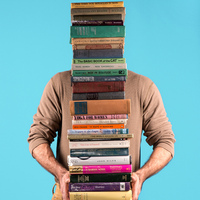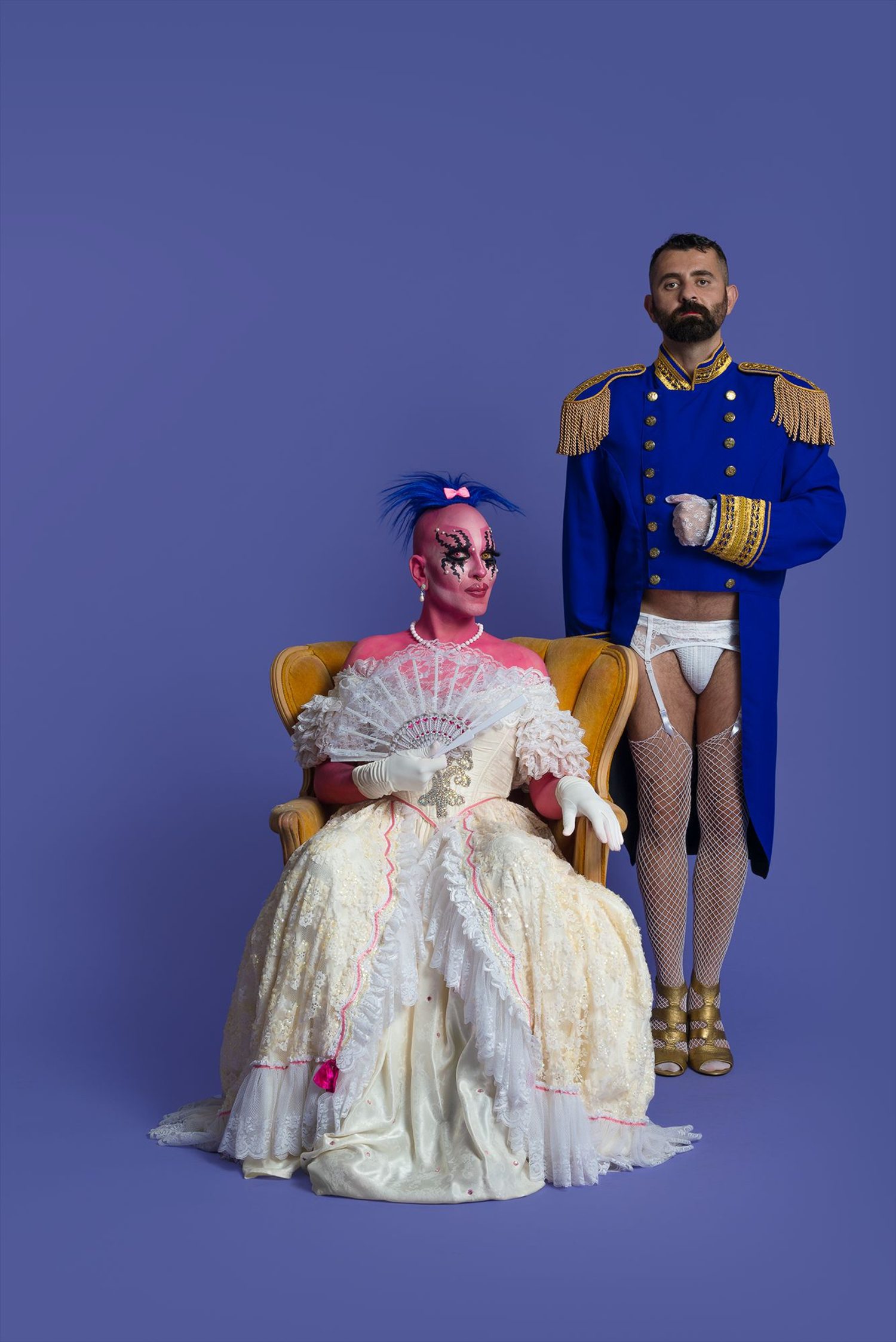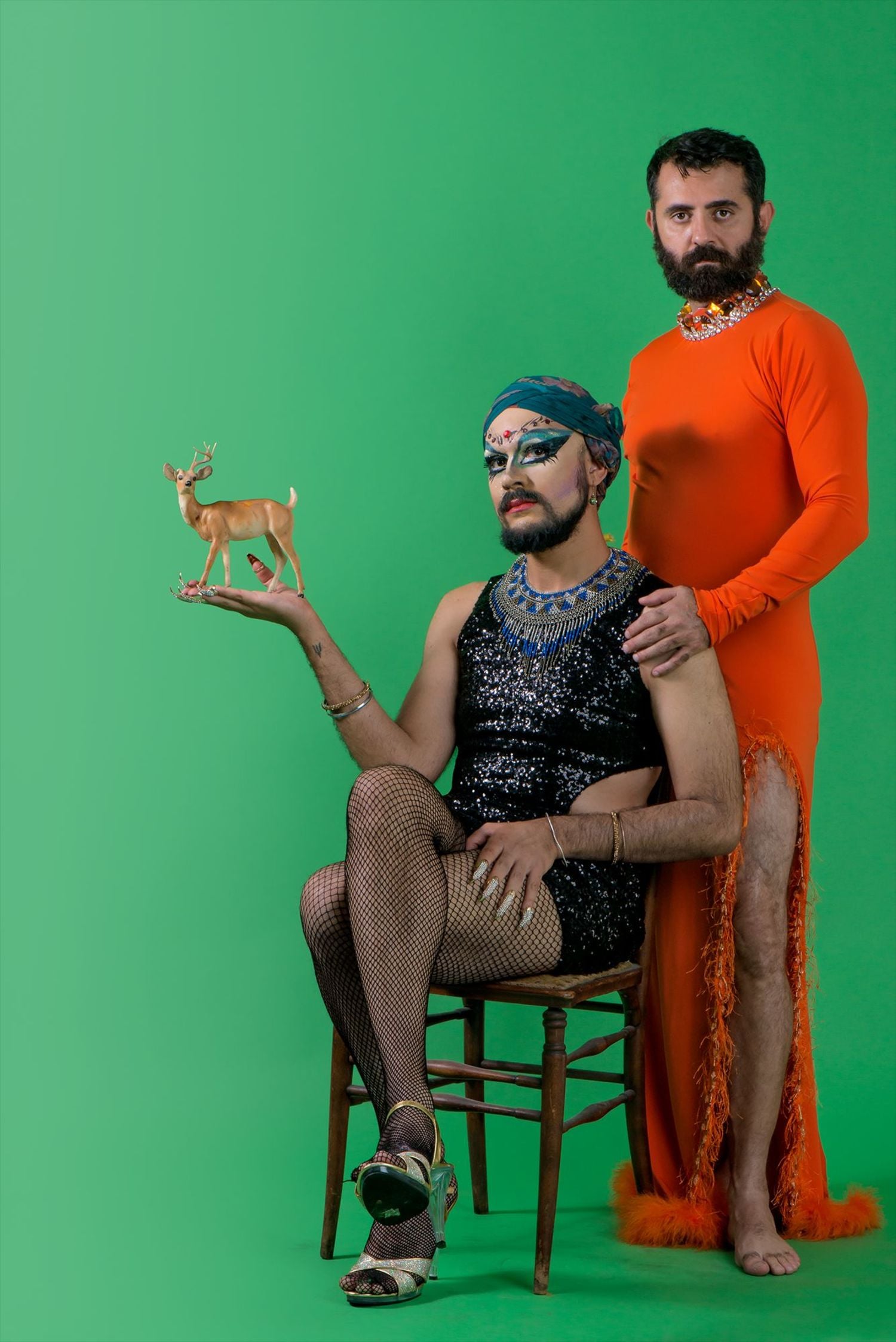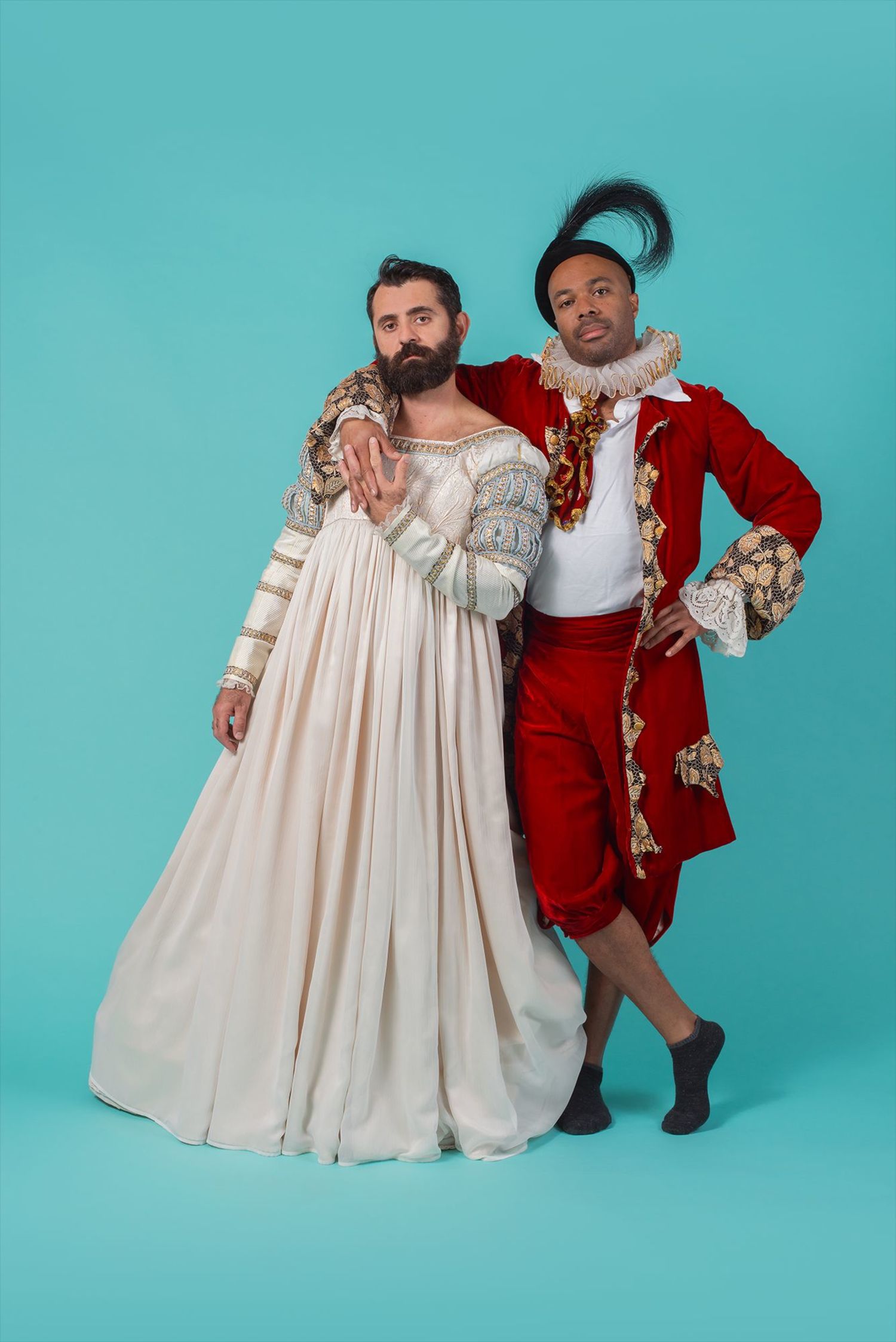There’s a look that photographer Jamil Hellu gives the camera in many of the portraits that make up his series Hues. It’s unflinching, like he’s not afraid of staring. When I recently saw this work on display at the Yerba Buena Center for the Art’s Bay Area Now 8 exhibition, my first instinct was to look away. It was like getting caught staring at someone on the train. Instead of simply hanging on the walls of the gallery, the portraits seem more alive – more cognizant of my attention.
This effect is powerful for a project like Hues because the people in these portraits seem all too familiar with being judged on their appearance. In each image, a queer acquaintance of Hellu’s poses before a backdrop of a single, solid color. They don’t sit alone. Hellu is always there, positioned in some way beside, below or above them. Sometimes the two are interacting with one another in some way. Other times, both photographer and subject stand side by side, coolly staring down the camera before them.
All this concentrated staring gives off a distinct sense of pride. And yet, using that word makes me feel self-conscious. And this is the effect Hellu is going for with Hues. He wants us to question our assumptions – to consider why we choose the words we do when assessing others. No doubt, there’s pride in this project, but why is that the word that comes to me first?
Besides making you second guess yourself, these photographs also make you laugh. You might laugh at a costume someone is wearing, or at the way Hellu and his subject are interacting with one another. Sometimes I laughed in disbelief, and sometimes I almost felt like I was laughing with the people in the photograph. Humor is at the heart of this project, and Hellu uses comedy with a sharpness that leaves me smiling.
There are so many ways to signify who we are to the world. Hues shows us some of the ways in which we identify ourselves, and it also shows us the inherent limitations involved. In putting this project together, I believe Hellu is diversifying the narrative of queerness and multiculturalism we’ve come to expect. We need projects like Hues and photographers like Hellu, because they carve out a space that we may not have known was there. In this interview for LensCulture, Hellu speaks about the importance of positive queer role models, the empowering side of humor, and the convergence of cultural heritage with queer sexuality.

Emily Shapiro: To start us off, I’d love to know more about how and when you started the Hues project.
Jamil Hellu: Representation of queer identity has been central to my work for many years. Prior to working on Hues, my projects considered my own Middle Eastern heritage through a queer lens. Thinking about ways of discussing the effects of homophobia, I produced a lot of work about the impact of cultural heritage on the expression of gay sexuality. During 2017, in the face of Donald Trump’s overtly discriminatory proclamations about immigrants, these ideas began to expand into larger questions about race. I started inviting members of the LGBTQ community to collaborate with me in developing a form of participatory portraiture that explores queer histories and ethnic heritages – of both my collaborators and my own Syrian and Brazilian cultural lineages.
ES: Your work is currently up at YBCA’s Bay Area Now 8 exhibit. How do you feel Hues fits into the identity of the Bay Area? Furthermore, what is your relationship to the Bay, and how do you think the city has impacted your work?
JH: Many images in Hues reflect the multicultural population of the Bay Area, which constitutes an enormous range of immigrants and international histories. I am an immigrant myself, and I’ve been living in San Francisco since 2000. The experience of living in this progressive and liberal city has been extremely influential on my art practice, inspiring me to continue to address themes of sexuality and gender identity. The countercultural spirit of the San Francisco Bay Area has opened my mind in so many ways. It has challenged me to further question my own personal upbringing in a socially-conservative Latin American environment dominated by strict Catholic moral values, where I often felt psychologically oppressed by public expressions of hyper-masculinity and by a lack of positive queer role models.

ES: Many of the photographs that make up this project include captions. As a viewer, I felt I was able to get a better taste of the world each subject comes from when I read these words. In fact, it reminded me of another Bay Area photographer, Jim Goldberg, and the way he invited his subjects to write something directly onto the printed image. In a way, Goldberg breaks down a barrier between the viewer and the subject by including this trace of a background – a human mark. Do you feel like you’re doing that by including text? How did you choose what to say about each person, or which quote to use?
JH: The title of each photograph in the form of a caption emerged as a desire to encourage a deeper and more layered dialogue with my audience. I ask my subjects to complete our collaboration by inviting them to describe our image. I then go through a diligent process of consolidating all the information into a brief yet insightful text. The goal is to share what I learned and what truthfully informs the image, without explaining it too much. My intention with the captions is to offer a better understanding about how complex and how meaningful each photograph is, contextualizing the significance of what we are wearing beyond what the viewers see and infer from the work. In a sense, the photographs’ meanings are grounded in the captions, and vice-versa. Your comparison to Goldberg’s work is an interesting one, since the text in his prints makes his images more relatable. I am working in a similar way, considering this idea of breaking down barriers between the viewer and the subject by further humanizing our stories in writing.

ES: I love the sense of playfulness in your work. The way you pose with your subjects feels both vulnerable and tongue-in-cheek. What do you think the role of humor is in this project?
JH: Humor has always been part of my work, ever since I first started making pictures. In many ways, it reflects my personality. Since I was young, I have used humor to express myself in playful and joking ways to make a point about something. Also, the vulnerability in the work comes directly from me not having any hesitation to make myself vulnerable. While most of the images in Hues appear to be full of play and humor, the portraits are often connected to a profound desire to combat homophobia and an ongoing fight for social recognition, acceptance, and historical inclusion. Instead of a façade, the humor is natural, and very much part of the work. It is my way of confronting important social themes face-to-face. The humor is empowering.
ES: Where do you find your subjects?
JH: With this series, I am moving far beyond my own circle of friends, often finding collaborators through recommendations, social media, and community events, for example. I truly welcome diversity. I am very open to meeting new people and to learning about their life stories and different cultures. As the work keeps growing, some people approach me asking to be part of the series, which is quite wonderful. As I meet with new participants and exchange personal stories, we discuss our ancestries, homophobia, and the desire of belonging to a community. We also discuss the ways our representation in the photographs can express something meaningful and constructive. Once we decide to stage a photograph, we intentionally plan its content, costumes, and color scheme.

ES: Have any of your subjects presented surprises that you weren’t anticipating?
JH: Yes, often, especially in front of the camera when we are being photographed. I am frequently surprised by how their stories inform many of the interactions and poses in the photographs. Some participants have cried or become very emotional during our photoshoot, stating the importance of having an opportunity such as this to express something psychologically painful, such as discrimination and homophobia.
ES: Do you feel like these photographs are a portrait of your subject, yourself, or both? Does this change from image to image?
JH: I believe it’s both. There is a strong commitment from both sides to create something meaningful and expressive, yet deeply personal. In some images, my presence is more emphatic than in others. Still, the ongoing cultural connection between two different people present in the series speaks to a larger social portrait, beyond the two of us in the image.

ES: I noticed several of your subjects mention the importance of fashion in their queerness. Katie Bush describes clothing as a “form of political armor,” and Carrie Morrison explains how much she hated wearing a male uniform at school in England. Tell me more about the outfits that are depicted in these photographs. Do they belong to you or the subject? How do the two of you decide what to wear?
JH: The outfits come from an extensive conversation with each subject. Everyone has very different ideas and contributions to each photoshoot. A lot of the costumes are put together through improvisation. Sometimes we rent them. Other times, we use garments that my collaborators already own, which were passed on to them by family members. These are relics, symbolic of their cultural lineages. It feels really meaningful to activate something in the photograph that would otherwise solely exist as personal memorabilia.
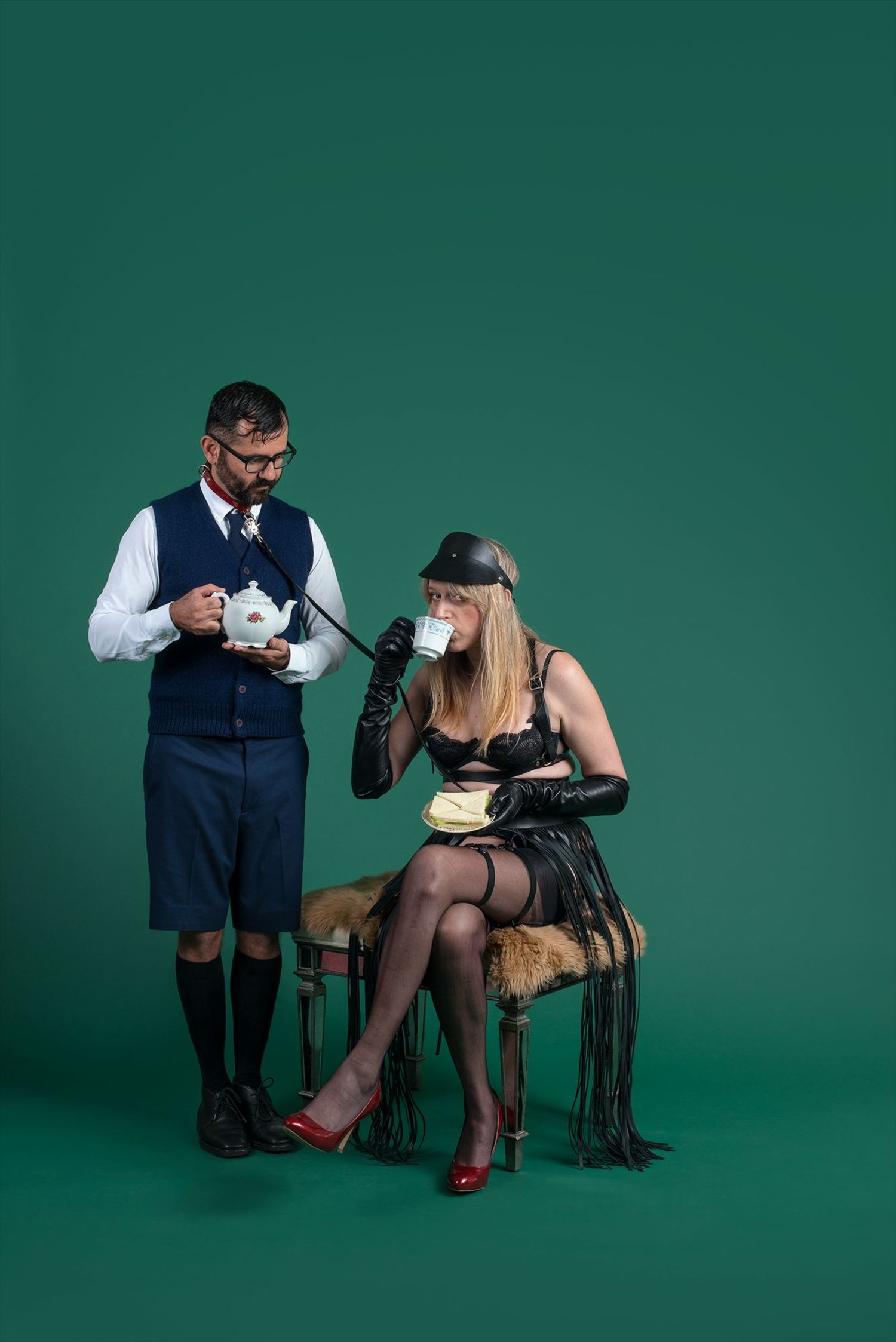
ES: This project is called Hues, so of course I can’t ignore the colors. The backdrop of every portrait in this project is a solid color. How do you choose which color is paired with which subject?
JH: Since the noun ‘hue’ means both a color and a shade of a color (for instance, green is a hue, and turquoise is a hue of both green and blue), the project’s title refers to the fluid nature of contemporary queerness, and to nuanced conceptions of gender, racial, and sexual identities. The choice of color for each photograph is an essential part of the collaboration between me and each participant in the project. We usually decide on a background color based on taste and personal meaning, often influenced by the hues of colors present in the costumes we are wearing.

ES: When I came out, I remember feeling like people were reimagining who I was. It was almost like they were rewriting our history together to make space for my sexuality. It felt awkward to me, and not entirely necessary. But I also recognized it as a form of acceptance. One of the things I love about this project is the way you test this. You seem to exaggerate certain aspects of your subjects to fit expectations or stereotypes. It feels both celebratory and limiting. How do you navigate honoring someone’s background versus creating a cliché?
JH: We all have a very distinctive understanding about our cultural lineages, and I am committed in finding a common denominator with my subject about what feels right to depict in each photograph. The intention is not only based on honoring something, but also confronting it, as a way to ask questions. On a personal level, I felt for many years that I was some sort of “walking stereotype” to people’s expectation of who they assumed I was because of my physical appearance or my gay identity. Also, after 9/11, I quickly began “to fit” into a stereotypical “Arab look” to some people, and was often being singled out at airports when traveling. Now, I intentionally use clichés in my work, searching for ways to turn them upside down. I test notions of stereotypes by purposefully employing them into the work to challenge their meanings. We can easily make assumptions about people based on race, religion, gender, and the way we dress. I am very interested in uncovering what happens when those assumptions are not met with the way we initially expected.


